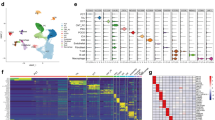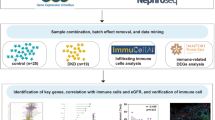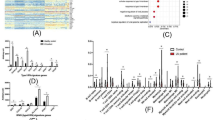Abstract
Diabetic kidney disease (DKD) is characterized by macrophage infiltration, which requires further investigation. This study aims to identify immune-related genes (IRGs) in macrophage and explore their potential as therapeutic targets. This study analyzed isolated glomerular cells from three diabetic mice and three control mice. A total of 59 glomeruli from normal kidney samples and 66 from DKD samples were acquired from four kidney transcriptomic profiling datasets. Bioinformatics analysis was conducted using both single-cell RNA (scRNA) and bulk RNA sequencing data to investigate inflammatory responses in DKD. Additionally, the “AUCell” function was used to investigate statistically different gene sets. The significance of each interaction pair was determined by assigning a probability using “CellChat.” The study also analyzed the biological diagnostic importance of immune hub genes for DKD and validated the expression of these immune genes in mice models. The top 2000 highly variable genes (HVGs) were identified after data normalization. Subsequently, a total of eight clusters were identified. It is worth mentioning that macrophages showed the highest percentage increase among all cell types in the DKD group. Furthermore, the present study observed significant differences in gene sets related to inflammatory responses and complement pathways. The study also identified several receptor-ligand pairs and co-stimulatory interactions between endothelial cells and macrophages. Notably, SYK, ITGB2, FCER1G, and VAV1 were identified as immunological markers of DKD with promising predictive ability. This study identified distinct cell clusters and four marker genes. SYK, ITGB2, FCER1G, and VAV1 may be important roles. Consequently, the present study extends our understanding regarding IRGs in DKD and provides a foundation for future investigations into the underlying mechanisms.
Graphical abstract
It shows the work flow of the study. The study comprised four sections. In the first section, the scRNA-seq data (GSE127235) from DKD were analyzed. The second section involved cell communication network analysis and AUCell scoring of cell clusters in DKD. The third section utilized bulk RNA-seq data (GSE 96804, GSE104948, GSE30122, and GSE30528) to validate and screen macrophage-specific IRGs and estimate immune cell infiltration. Finally, the fourth part involved in vivo experiments (RT-qPCR, western blot, and immunohistochemistry) to validate the expression of hub genes. Abbreviations: UMAP, uniform manifold approximation and projection; DKD, diabetic kidney disease; RNA-seq, RNA sequencing; DEGs, differentially expressed genes; ROC, receiver operating characteristic.







Similar content being viewed by others
Data Availability
All data generated and/or analyzed during the study are presented in this article and are available from the corresponding author upon reasonable request.
References
de Boer, I.H., K. Khunti, T. Sadusky, et al. 2022. Diabetes management in chronic kidney disease: a consensus report by the American Diabetes Association (ADA) and Kidney Disease: Improving Global Outcomes (KDIGO). Diabetes Care. https://doi.org/10.2337/dci22-0027.
Deng, Y., N. Li, Y. Wu, et al. 2021. Global, regional, and national burden of diabetes-related chronic kidney disease from 1990 to 2019. Frontiers in Endocrinology 12: 672350. https://doi.org/10.3389/fendo.2021.672350.
Anders, H.J., T.B. Huber, B. Isermann, et al. 2018. CKD in diabetes: diabetic kidney disease versus nondiabetic kidney disease. Nature Reviews. Nephrology 14: 361–377. https://doi.org/10.1038/s41581-018-0001-y.
Stewart, B.J., and M.R. Clatworthy. 2020. Applying single-cell technologies to clinical pathology: progress in nephropathology. The Journal of Pathology 250: 693–704. https://doi.org/10.1002/path.5417.
Park, J., R. Shrestha, C. Qiu, et al. 2018. Single-cell transcriptomics of the mouse kidney reveals potential cellular targets of kidney disease. Science 360: 758–763. https://doi.org/10.1126/science.aar2131.
Der, E., S. Ranabothu, H. Suryawanshi, et al. 2017. Single cell RNA sequencing to dissect the molecular heterogeneity in lupus nephritis. JCI Insight 2: e93009. https://doi.org/10.1172/jci.insight.93009.
Wu, H., A.F. Malone, E.L. Donnelly, et al. 2018. Single-cell transcriptomics of a human kidney allograft biopsy specimen defines a diverse inflammatory response. Journal of the American Society of Nephrology 29: 2069–2080. https://doi.org/10.1681/ASN.2018020125.
Fu, J., K.M. Akat, Z. Sun, et al. 2019. Single-cell RNA profiling of glomerular cells shows dynamic changes in experimental diabetic kidney disease. Journal of the American Society of Nephrology 30: 533–545. https://doi.org/10.1681/asn.2018090896.
Perez-Morales, R.E., M.D. Del Pino, J.M. Valdivielso, et al. 2019. Inflammation in diabetic kidney disease. Nephron 143: 12–16. https://doi.org/10.1159/000493278.
Katherine, R., R.A. Tuttle, Charles E. Alpers, George L. Bakris, Frank C. Brosius, Peter Kolkhof, and Jaime Uribarri. 2022. Molecular mechanisms and therapeutic targets for diabetic kidney disease. Kidney International 102: 248–260. https://doi.org/10.1016/j.kint.2022.05.012.
Calle, P., and G. Hotter. 2020. Macrophage phenotype and fibrosis in diabetic nephropathy. International Journal of Molecular Sciences 21: 2806. https://doi.org/10.3390/ijms21082806.
Fu, J., Z. Sun, X. Wang, et al. 2022. The single-cell landscape of kidney immune cells reveals transcriptional heterogeneity in early diabetic kidney disease. Kidney International. https://doi.org/10.1016/j.kint.2022.08.026.
Pan, Y., S. Jiang, Q. Hou, et al. 2018. Dissection of glomerular transcriptional profile in patients with diabetic nephropathy: SRGAP2a protects podocyte structure and function. Diabetes 67: 717–730. https://doi.org/10.2337/db17-0755.
Grayson, P.C., S. Eddy, J.N. Taroni, et al. 2018. Metabolic pathways and immunometabolism in rare kidney diseases. Annals of the Rheumatic Diseases 77: 1226–1233. https://doi.org/10.1136/annrheumdis-2017-212935.
Woroniecka, K.I., A.S. Park, D. Mohtat, et al. 2011. Transcriptome analysis of human diabetic kidney disease. Diabetes 60: 2354–2369. https://doi.org/10.2337/db10-1181.
Efremova, M., M. Vento-Tormo, S.A. Teichmann, et al. 2020. Cell PhoneDB: Inferring cell-cell communication from combined expression of multi-subunit ligand-receptor complexes. Nature Protocols 15: 1484–1506. https://doi.org/10.1038/s41596-020-0292-x.
Tang, S.C.W., and W.H. Yiu. 2020. Innate immunity in diabetic kidney disease. Nature Reviews Nephrology 16: 206–222. https://doi.org/10.1038/s41581-019-0234-4.
Chen, J., Q. Liu, J. He, et al. 2022. Immune responses in diabetic nephropathy: Pathogenic mechanisms and therapeutic target. Frontiers in Immunology 13: 958790. https://doi.org/10.3389/fimmu.2022.958790.
Li, H.-D., Y.-K. You, B.-Y. Shao, et al. 2022. Roles and crosstalks of macrophages in diabetic nephropathy. Frontiers in Immunology 13: 1015142. https://doi.org/10.3389/fimmu.2022.1015142.
Boels, M.G.S., A. Koudijs, M.C. Avramut, et al. 2017. Systemic monocyte chemotactic protein-1 inhibition modifies renal macrophages and restores glomerular endothelial glycocalyx and barrier function in diabetic nephropathy. American Journal of Pathology 187: 2430–2440. https://doi.org/10.1016/j.ajpath.2017.07.020.
Lim, A.K., F.Y. Ma, D.J. Nikolic-Paterson, et al. 2009. Antibody blockade of c-fms suppresses the progression of inflammation and injury in early diabetic nephropathy in obese db/db mice. Diabetologia 52: 1669–1679. https://doi.org/10.1007/s00125-009-1399-3.
Park, M.D., A. Silvin, F. Ginhoux, et al. 2022. Macrophages in health and disease. Cell 185: 4259–4279. https://doi.org/10.1016/j.cell.2022.10.007.
Loke, P., and J.D. Lin. 2022. Redefining inflammatory macrophage phenotypes across stages and tissues by single-cell transcriptomics. Science Immunology 7: eabo4652. https://doi.org/10.1126/sciimmunol.abo4652.
Li, L., H. Fu, and Y. Liu. 2022. The fibrogenic niche in kidney fibrosis: components and mechanisms. Nature Reviews. Nephrology 18: 545–557. https://doi.org/10.1038/s41581-022-00590-z.
Wu, L., C. Liu, D.Y. Chang, et al. 2021. Annexin A1 alleviates kidney injury by promoting the resolution of inflammation in diabetic nephropathy. Kidney International 100: 107–121. https://doi.org/10.1016/j.kint.2021.02.025.
Ke, G., X. Chen, R. Liao, et al. 2021. Receptor activator of NF-kappaB mediates podocyte injury in diabetic nephropathy. Kidney International 100: 377–390. https://doi.org/10.1016/j.kint.2021.04.036.
Zhou, T., L. Sun, S. Yang, et al. 2020. 20(S)-ginsenoside Rg3 protects kidney from diabetic kidney disease via renal inflammation depression in diabetic rats. Journal of Diabetes Research 2020: 7152176. https://doi.org/10.1155/2020/7152176.
Xu, H., X. Wu, H. Qin, et al. 2015. Myocardin-related transcription factor A epigenetically regulates renal fibrosis in diabetic nephropathy. Journal of the American Society of Nephrology 26: 1648–1660. https://doi.org/10.1681/ASN.2014070678.
Wang, L., D. Aschenbrenner, Z. Zeng, et al. 2021. Gain-of-function variants in SYK cause immune dysregulation and systemic inflammation in humans and mice. Nature Genetics 53: 500–510. https://doi.org/10.1038/s41588-021-00803-4.
Qiao, Y., X. Tian, L. Men, et al. 2018. Spleen tyrosine kinase promotes NLR family pyrin domain containing 3 inflammasome-mediated IL-1beta secretion via c-Jun N-terminal kinase activation and cell apoptosis during diabetic nephropathy. Molecular Medicine Reports 18: 1995–2008. https://doi.org/10.3892/mmr.2018.9164.
Liu, L., X. Pang, W. Shang, et al. 2020. miR-136 improves renal fibrosis in diabetic rats by targeting down-regulation of tyrosine kinase SYK and inhibition of TGF-beta1/Smad3 signaling pathway. Renal Failure 42: 513–522. https://doi.org/10.1080/0886022X.2020.1764854.
Yang, W.S., J.W. Chang, N.J. Han, et al. 2012. Spleen tyrosine kinase mediates high glucose-induced transforming growth factor-beta1 up-regulation in proximal tubular epithelial cells. Experimental Cell Research 318: 1867–1876. https://doi.org/10.1016/j.yexcr.2012.05.016.
Yang, W.S., J.W. Seo, N.J. Han, et al. 2008. High glucose-induced NF-kappaB activation occurs via tyrosine phosphorylation of IkappaBalpha in human glomerular endothelial cells: involvement of Syk tyrosine kinase. American Journal of Physiology. Renal Physiology 294: F1065–F1075. https://doi.org/10.1152/ajprenal.00381.2007.
Yang, W.S., J.S. Kim, N.J. Han, et al. 2015. Toll-like receptor 4/spleen tyrosine kinase complex in high glucose signal transduction of proximal tubular epithelial cells. Cellular Physiology and Biochemistry 35: 2309–2319. https://doi.org/10.1159/000374034.
Song, X., M. Gong, Y. Chen, et al. 2019. Nine hub genes as the potential indicator for the clinical outcome of diabetic nephropathy. Journal of Cellular Physiology 234: 1461–1468. https://doi.org/10.1002/jcp.26958.
Liu, S., C. Wang, H. Yang, et al. 2020. Weighted gene co-expression network analysis identifies FCER1G as a key gene associated with diabetic kidney disease. Annals of Translational Medicine 8: 1427. https://doi.org/10.21037/atm-20-1087.
Chou, C., X. Zhang, C. Krishna, et al. 2022. Programme of self-reactive innate-like T cell-mediated cancer immunity. Nature 605: 139–145. https://doi.org/10.1038/s41586-022-04632-1.
Morrish, E., and J. Ruland. 2022. Cytotoxic FCER1G(+) innate-like T cells: New potential for tumour immunotherapy. Signal Transduction and Targeted Therapy 7: 204. https://doi.org/10.1038/s41392-022-01061-4.
Huang, R., G. Guo, L. Lu, et al. 2019. The three members of the Vav family proteins form complexes that concur to foam cell formation and atherosclerosis. Journal of Lipid Research 60: 2006–2019. https://doi.org/10.1194/jlr.M094771.
Fukumoto, K., M. Sakata-Yanagimoto, M. Fujisawa, et al. 2020. VAV1 mutations contribute to development of T-cell neoplasms in mice. Blood 136: 3018–3032. https://doi.org/10.1182/blood.2020006513.
Ma, J., W. Hu, D. Zhang, et al. 2021. CD226 knockout alleviates high-fat diet induced obesity by suppressing proinflammatory macrophage phenotype. Journal of Translational Medicine 19: 477. https://doi.org/10.1186/s12967-021-03150-4.
Zhou, H., Z. Yang, L. Mu, et al. 2022. Integrated analysis of multiple microarray studies to identify core gene-expression signatures involved in tubulointerstitial injury in diabetic nephropathy. BioMed Research International 2022: 9554658. https://doi.org/10.1155/2022/9554658.
Xu, B., L. Wang, H. Zhan, et al. 2021. Investigation of the mechanism of complement system in diabetic nephropathy via bioinformatics analysis. Journal of Diabetes Research 2021: 5546199. https://doi.org/10.1155/2021/5546199.
Hu, Y., S. Liu, W. Liu, et al. 2021. Bioinformatics analysis of genes related to iron death in diabetic nephropathy through network and pathway levels based approaches. PLoS One 16: e0259436. https://doi.org/10.1371/journal.pone.0259436.
Geng, X.D., W.W. Wang, Z. Feng, et al. 2019. Identification of key genes and pathways in diabetic nephropathy by bioinformatics analysis. Journal of Diabetes Investigation 10: 972–984. https://doi.org/10.1111/jdi.12986.
Huang, J., and Q. Zhou. 2022. CD8+T cell-related gene biomarkers in macular edema of diabetic retinopathy. Frontiers in Endocrinology 13: 907396. https://doi.org/10.3389/fendo.2022.907396.
Liu, L., Q. Zhao, M. Kong, et al. 2022. Myocardin-related transcription factor A regulates integrin beta 2 transcription to promote macrophage infiltration and cardiac hypertrophy in mice. Cardiovascular Research 118: 844–858. https://doi.org/10.1093/cvr/cvab110.
Herb, M., A. Gluschko, and M. Schramm. 2018. LC3-associated phagocytosis initiated by integrin ITGAM-ITGB2/Mac-1 enhances immunity to Listeria monocytogenes. Autophagy 14: 1462–1464. https://doi.org/10.1080/15548627.2018.1475816.
Zheng, J.M., Z.H. Jiang, D.J. Chen, et al. 2019. Pathological significance of urinary complement activation in diabetic nephropathy: a full view from the development of the disease. Journal of Diabetes Investigation 10: 738–744. https://doi.org/10.1111/jdi.12934.
Funding
This work was supported by financial support from Tianjin Science and Technology Major Special Project and Engineering Public Health Science and Technology Major Special Project (No. 21ZXGWSY00100), Tianjin Natural Science Foundation Key Project (No. 22JCZDJC00590), Tianjin Key Medical Discipline (Specialty) Construct Project (No. TJYXZDXK-032A), and Scientific Research Funding of Tianjin Medical University Chu Hsien-I Memorial Hospital (No. ZXY-ZDSYSZD-1).
Author information
Authors and Affiliations
Contributions
Xian Shao: conceptualization, methodology, writing—original draft, investigation, validation, experiments, data curation, and visualization. Yueyue Shi and Yao Wang: conceptualization, validation, experiments, and review and editing. Li Zhang, Pufei Bai, JunMei Wang, Ashanjiang aniwan, and Yao Lin: validation, investigation, and experiments. Saijun Zhou: supervision and conceptualization. Pei Yu: conceptualization, resources, methodology, funding acquisition, supervision, and project administration. All authors reviewed and approved the manuscript.
Corresponding author
Ethics declarations
Ethics Approval
Animal experiments were performed with the approval of the Tianjin Medical University Animal Ethics Committee (No. 220916002).
Consent for Publication
Written informed consent for publication was obtained from all participants.
Conflict of Interest
The authors declare no competing interests.
Additional information
Publisher's Note
Springer Nature remains neutral with regard to jurisdictional claims in published maps and institutional affiliations.
Supplementary Information
Below is the link to the electronic supplementary material.
Rights and permissions
Springer Nature or its licensor (e.g. a society or other partner) holds exclusive rights to this article under a publishing agreement with the author(s) or other rightsholder(s); author self-archiving of the accepted manuscript version of this article is solely governed by the terms of such publishing agreement and applicable law.
About this article
Cite this article
Shao, X., Shi, Y., Wang, Y. et al. Single-Cell Sequencing Reveals the Expression of Immune-Related Genes in Macrophages of Diabetic Kidney Disease. Inflammation 47, 227–243 (2024). https://doi.org/10.1007/s10753-023-01906-2
Received:
Revised:
Accepted:
Published:
Issue Date:
DOI: https://doi.org/10.1007/s10753-023-01906-2




